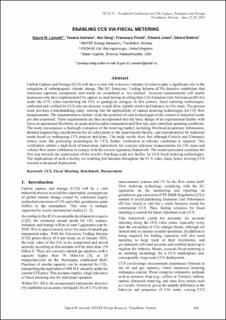| dc.contributor.author | Løvseth, Sigurd W. | |
| dc.contributor.author | Arellano, Yessica | |
| dc.contributor.author | Deng, Han | |
| dc.contributor.author | Finotti, Francesco | |
| dc.contributor.author | Jukes, Edward | |
| dc.contributor.author | Bottino, Gérard | |
| dc.date.accessioned | 2021-10-01T09:52:06Z | |
| dc.date.available | 2021-10-01T09:52:06Z | |
| dc.date.issued | 2021 | |
| dc.identifier.isbn | 978-82-536-1714-5 | |
| dc.identifier.issn | 2387-4295 | |
| dc.identifier.uri | https://hdl.handle.net/11250/2786939 | |
| dc.description.abstract | Carbon Capture and Storage (CCS) will have to turn into a massive industry in order to play a significant role in the mitigation of anthropogenic climate change. The EU Emissions Trading Scheme (ETS) directive establishes that emissions captured, transported, and stored are considered as ‘not emitted.’ Accurate measurements will enable businesses who have implemented CO2 capture to omit buying or selling their CO2 Emission Unit Allowances (EUAs) under the ETS, when transferring the CO2 to geological storages. In this context, fiscal metering technologies, calibrated and verified for CCS relevant streams, would allow rightful checks and balances in CO2 trade. The present work provides a benchmarking study, looking into the applicability of various metering technologies for CO2 flow measurements. The requirements to further verify the potential of such technologies in the context of industrial needs are also examined. These requirements are then incorporated into the basic design of an experimental facility with focus on operational flexibility, accurate and traceable composition and flow rate, and controlled operating conditions. The study encompasses a thorough evaluation of the metering market, including first-hand proprietary information, detailed engineering considerations for all subsystems of the experimental facility, and considerations for industrial needs based on undergoing CCS projects and plans. The study results show that although Coriolis and Ultrasonic meters seem like promising technologies for CCS, further verification at relevant conditions is required. This verification entitles a high level of innovation, particularly for accurate reference measurements for CO2 mass and volume flow meter calibration to comply with the current regulatory framework. The results presented constitute the first step towards the construction of the world’s first large-scale test facility for CCS fiscal metering technologies. The implications of such a facility are enabling fair business throughout the CCS value chain, hence levering CCS towards widespread deployment. | en_US |
| dc.language.iso | eng | en_US |
| dc.publisher | SINTEF Academic Press | en_US |
| dc.relation.ispartof | TCCS–11. CO2 Capture, Transport and Storage. Trondheim 22nd–23rd June 2021.
Short Papers from the 11th International Trondheim CCS Conference | |
| dc.relation.ispartofseries | SINTEF Proceedings;7 | |
| dc.rights | CC BY 4.0 | * |
| dc.rights.uri | https://creativecommons.org/licenses/by/4.0/ | * |
| dc.subject | CCS | en_US |
| dc.subject | Fiscal Metering | en_US |
| dc.subject | Benchmark | en_US |
| dc.subject | Measurement | en_US |
| dc.title | Enabling CCS via Fiscal Metering | en_US |
| dc.type | Chapter | en_US |
| dc.type | Peer reviewed | en_US |
| dc.type | Conference object | en_US |
| dc.description.version | publishedVersion | en_US |
| dc.rights.holder | © 2021 The Authors. Published by SINTEF Academic Press. | en_US |
| dc.subject.nsi | VDP::Teknologi: 500 | en_US |
| dc.identifier.cristin | 1937689 | |
| dc.relation.project | Norges forskningsråd: 257579 | en_US |
| dc.relation.project | Norges forskningsråd: 296486 | en_US |

